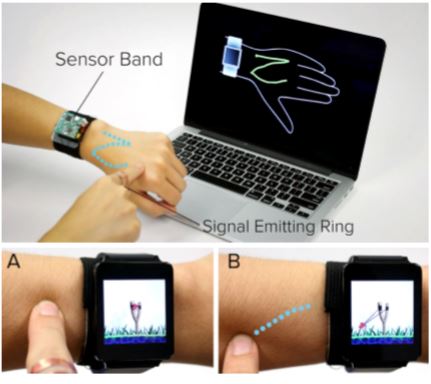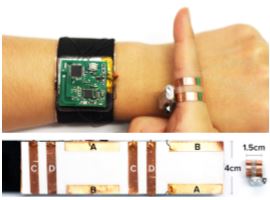Engineers at Carnegie Mellon University have developed a rather interesting method of interacting with your smartwatch. In a exciting new development, addition of their designed board turns your skin into a touchscreen for your smartwatch. Who knows, you won’t even buy a smartphone in a few years.

Navigating through the apps is one of the biggest challenges with smartwatches due to their relatively tiny screen. While smartphones and tablets have gotten bigger over the years, the gadgets on our wrists need to stay small due to their placement. This might get confusing with the number of applications installed on your device. This provides an easy solution to such problems.

The system uses a signal-emitting ring worn on the finger to communicate with a sensing band attached to the watch. When the finger wearing the ring touches the skin, a high-frequency electrical signal spreads across your arm. It uses the distance between the ring and four pairs of electrodes in the watchband to triangulate the position of your finger in 2D space. “The great thing about SkinTrack is that it’s not obtrusive; watches and rings are items that people already wear every day,” said Yang Zhang, a first-year Ph.D. student at CMU who worked on the technology.
You can swipe up and down on your wrist to move between apps, left or right to enter and exit a program. This can be really made interesting by the next feature. The really cool stuff happens when you start using your skin as a canvas. You can drag apps off the watch and place them on parts of your arm, creating shortcuts back to the app.
Put your Twitter app on your elbow, for example, and you can quickly access it from that spot with a tap of the finger wearing the ring. Adding all that area to the touchscreen of your smart watch also opens up possibilities for the watch as a gaming device. Now pull as hard as possible you want in Angry Birds.
The device is still under development and there are several kinks to work out. According to the lab, “keeping the ring powered up is a challenge. Signals also tend to change as the device is worn for long periods, thanks to factors such as sweat and hydration and the fact the body is in constant motion.” However, ” The technology is safe. No evidence suggests that the radio frequency signals used by SkinTrack have any health effects. The body is commonly excited by daily appliances — everything from the tiny amounts of current drawn from the finger by touchscreens to the electromagnetic noise emanating from fluorescent lights — with no ill effects.”






